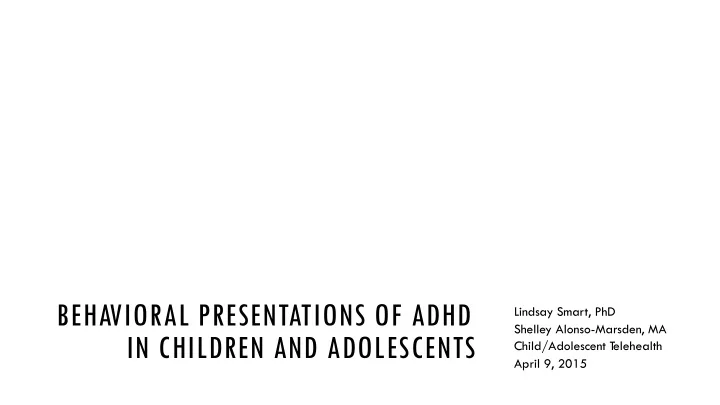

BEHAVIORAL PRESENTATIONS OF ADHD Lindsay Smart, PhD Shelley Alonso-Marsden, MA IN CHILDREN AND ADOLESCENTS Child/Adolescent T elehealth April 9, 2015
WHAT DO YOU THINK WHEN YOU THINK “ ADHD”?
HYPERACTIVE KID IN KID’S CHOIR
ADHD SUBTYPES
HYPERACTIVE-IMPULSIVE SUBTYPE o Fidgets with hands or feet or squirms in chair. o Has difficulty remaining seated. o Runs about or climbs excessively in children; extreme restlessness in adults. o Difficulty engaging in activities quietly. o Acts as if driven by a motor; adults will often feel inside like they were driven by a motor. o T alks excessively. o Blurts out answers before questions have been completed. o Difficulty waiting or taking turns. o Interrupts or intrudes upon others. American Psychiatric Association, 2013
INATTENTIVE SUBTYPE o Fails to give close attention to details or makes careless mistakes. o Has difficulty sustaining attention. o Does not appear to listen. o Struggles to follow through on instructions. o Has difficulty with organization. o Avoids or dislikes tasks requiring a lot of thinking. o Loses things. o Is easily distracted. o Is forgetful in daily activities. American Psychiatric Association, 2013
HOW TO SPOT INATTENTION IN KIDS Fails to give close attention to details or makes careless mistakes. Example: -“Chris” – 12-year-old male therapy client - Referred to therapy for failing grades in 6 th grade due to missing assignments and frequent errors in completed work.
HOW TO SPOT INATTENTION IN KIDS Has difficulty sustaining attention Example: -“Lisa” – 7-year-old female brought in for testing by her mother -During testing session, Lisa asks for frequent breaks during subtests. She asks to play a board game but loses interest quickly and asks to play another before the first is complete.
HOW TO SPOT INATTENTION IN KIDS Not seeming to listen when spoken to Example: -“Maria” – 9-year-old female therapy client -Ongoing family conflict related to child seemingly ignoring her parents when they are talking to her.
HOW TO SPOT INATTENTION IN KIDS Struggles to follow through on instructions. Example: -“Jose” – 6-year-old male testing case -Normal IQ. Difficulty completing age- appropriate multistep instructions (e.g., getting ready in the morning)
HOW TO SPOT INATTENTION IN KIDS Has difficulty with organization. Example: -“Scott” – 13-year-old male therapy client -Referred to therapy for failing grades in 6 th grade due to missing assignments and frequent errors in completed work.
HOW TO SPOT INATTENTION IN KIDS Avoids or dislikes tasks requiring a lot of thinking. Example: -“Steven” – 14-year-old male therapy client -Moved to online school following bullying in middle school. Difficulty completing school tasks due to spending hours daily on video games and internet videos.
HOW TO SPOT INATTENTION IN KIDS Loses things. Example: -“Emily” – 9-year-old female therapy client -Frequent family conflict due to child frequently misplacing both small (gloves, hat) and expensive (iPod) items at school.
HOW TO SPOT INATTENTION IN KIDS • Is easily distracted. Example: • - “Rachel” – 10-year-old female therapy patient with primary anxiety • -Has difficulty maintaining course of therapeutic conversation. Frequently changes topic back to her interests (My Little Pony)
HOW TO SPOT INATTENTION IN KIDS Is forgetful in daily activities. Example: -“Peter” – 21-year-old male testing client -Referred for testing after failing first semester of college. Peter reports that he was unable to remember assignments, class schedule, and social engagements.
ADHD IN GIRLS
WHY MANY GIRLS WITH ADHD ARE LEFT UNTREATED http://www.nbcnews.com/watch/nightly-news/why-many-girls- with-adhd-are-left-untreated-371523139576
ADHD IN GIRLS Boys are more than twice as likely to be diagnosed with ADHD as girls (CDC, 2015) Girls more likely to exhibit inattentive subtype (Hinshaw , 2002) Population-based studies indicate similar levels of ADHD between boys and girls (Froehlich et al., 2007) Girls are more likely to internalize difficulties, labeling themselves “stupid” and show more depression and suicidal thoughts by adolescence (Gershon, 2002) Girls with hyperactive-impulsive subtype more likely to attempt suicide (Hinshaw et al., 2012)
AGE AND ADHD
ADHD IN ADOLESCENCE Hyperactivity declines in adolescence (Ingram, Hechtman, & Morgenstern, 1995) Expectations for academic independence increase over the course of school Children with ADHD may have more academic difficulty as they enter middle and high school (Brown, 2000) Impulsive risky behavior ( CHADD, 2008) : Driving Alcohol and drug use Lying Stealing Unprotected sex
EXECUTIVE FUNCTIONING DEFICITS
EXECUTIVE FUNCTIONING DEFICITS IN ADHD Across studies, children with ADHD display significant Executive Functioning deficits (Willcutt et al., 2005) Basics of Executive Function: W orking memory Ability to retain and manipulate distinct pieces of information over short periods of time. Mental flexibility Ability to sustain or shift attention in response to different demands or to apply different rules in different settings. Inhibitory control/Self-control Ability to set priorities and resist impulsive actions or responses.
INBRIEF: EXECUTIVE FUNCTION: SKILLS FOR LIFE AND LEARNING
SOCIAL DEFICITS
SOCIAL DEFICITS IN ADHD Kids with ADHD are more likely to: o Have difficulty reading social cues; for example, they may interrupt or have trouble taking turns. o Have problems learning social skills, such as conversation skills and problem-solving. o Have trouble controlling their behavior and emotions. Other children may find their hyperactive or impulsive behavior irritating. o Be very physical or aggressive. o React angrily or inappropriately when they are upset. o Have trouble cooperating with friends. McAuley, 2009
Recommend
More recommend